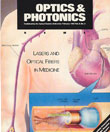
February 1991 Issue
Feature Articles
4 decades of optical information processing
The fact that my title mentions four decades of optical information processing should not be taken to mean that I personally participated in all of those decades. In fact, I joined the field of optics by pure accident in 1963, after a Ph.D. in the field of radar signal processing. I participated in the last three of the four decades, and I was close enough to the first decade to have been influenced by it extensively. The 1960s were exciting times. The HeNe laser had just become commercially available. New ideas were surfacing in the field of holography that had great appeal to one trained in systems theory. From the perspective of academia, Ph.D. thesis topics were plentiful.
by Joseph W. GoodmanLasers and Optical Fibers in Medicine
Two thousand years ago, the historian Plinius mentioned in his book Naturalis Historia that "the laser is numbered among the most miraculous gifts of nature and lends itself to various applications." This ancient laser was a plant that was used to cure various diseases. During the last 30 years, modern lasers have gradually penetrated the medical arena and they are being used for diagnostic and therapeutic procedures. At the same time, there has been rapid progress in the development of low loss optical fibers for communication systems. This served as the basis for the use of optical fibers in medical applications such as endoscopic imaging, fiber optic sensing, and laser power transmission. Integrated laser-fiber systems as the laser endoscope or the laser catheter will facilitate imaging, diagnostics, and therapy inside the body. These "least invasive" techniques have already been tried clinically in various medical disciplines and are bound to have a tremendous impact on medicine.
by Abraham KatzirScience exhibit contest takes us back to our roots
Many of us in the scientific and engineering community can trace our professional beginnings to local science museums. In my case, the Brooklyn science museum played an important role in sparking a teenage interest in astronomy that evolved into a career in atomic physics and laser spectroscopy. Jarus Quinn, OSA's executive director, has told me that, as a boy, he was influenced significantly by programs and exhibits at the Franklin Institute— Science Museum of Philadelphia.
by Michael LittmanOptics: A costly business without standards
Last summer, an ANSI accredited, domestic optical standards writing body was set up under the auspices of the National Association of Photographic Manufacturers (NAPM). This group— OP1—is a subcommittee of ANSI PH3 -Photographic Apparatus, chaired by Andy DiDonato of Polaroid Corp.; Richard Hittner of NAPM serves as secretary. For the time being, I am chairing 0P1, which will have a subcommittee structure similar to the ISO/TC172 organization. Eduard Scherrer of NAPM will assist Hittner in the administration of the domestic optical standards body. As with any such formal structure, there will be associated administrative costs. These will be determined by the activity of the group—roughly in the neighborhood of $35,000 a year for NAPM and ANSI expenses. This is separate from the expenses borne by the participants in the actual standards writing activity.
by Robert S. ParksFun with flashlights by the fire
It's sometimes pleasant to spend an evening in front of a fireplace or campfire with kids. You turn off the TV, the radio, and the lights, and settle down for stories, talk, maybe s'mores. In these cozy surroundings, you can also entertain the kids with some interesting optics demonstrations using nothing more than a flashlight. Depending on your kids' ages and moods, you might stage a few demonstrations or you could simply point out one or two phenomenon.
by Janet Shields

![A multiplexed image of a human tonsil acquired. [NIAID] using the iterative bleaching extends multiplexity (IBEX) method.](https://opnmedia.blob.core.windows.net/$web/opn/media/images/articles/2024/0424/departments/202404-cover-web.jpg?ext=.jpg)
